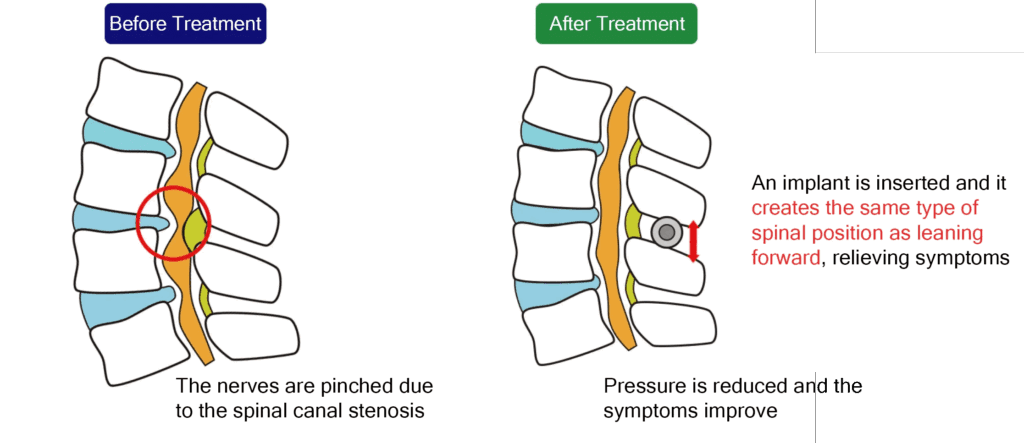September 26, 2025
Spinal stenosis is a condition where the neural passageway inside the spine—the spinal canal—narrows. It is reported to be the most common spinal disorder (*1).
*1: Yutaka Nohara et al., “Spinal Surgery Survey by the Japan Spine and Spinal Cord Society,” Journal of the Japan Spine and Spinal Cord Society, Vol. 15, No. 2, 2004.
When the spinal canal narrows, it compresses the nerves, causing pain and numbness from the lower back down to the legs. As spinal stenosis progresses, it can significantly impair daily life.
This article explains the progression and countermeasures for spinal stenosis.
What is Spinal Stenosis?
Spinal stenosis is a condition where the spinal canal, the pathway for nerves, becomes constricted (narrowed), leading to nerve compression. When the cause is an unstable lumbar spine, pain is often triggered by movement.
In lumbar spinal stenosis, symptoms include numbness and pain from the lower back down. A key characteristic is intermittent claudication, where walking causes pain and numbness in the buttocks or legs, forcing the person to rest for relief, only for the pain to return when they start walking again.

The different levels of severity in spinal stenosis
脊柱管狭窄症の重症度は4段階に分かれています。
① Mild
Characteristics: The patient experiences pain or other symptoms when standing or sitting, but typically has no issues while walking.
Impact: Mild cases rarely interfere with daily life, but if left untreated, the narrowing may progress.
Treatment: Conservative therapies such as medication, physical therapy, and nerve block injections are often expected to provide symptom relief.
② Moderate
Characteristics: Intermittent claudication begins to occur. The patient feels pain and numbness in the legs after walking for about 10 to 20 minutes, requiring a rest to continue walking.
Treatment: At this stage, not only conservative therapy but also surgery may be considered in some cases.
③ Severe
Characteristics: Intermittent claudication occurs after walking for less than 10 minutes. Symptoms such as muscle weakness and a feeling of loss of strength also appear.
Impact: Since severe stenosis significantly affects daily life, surgical intervention is often the first choice for treatment in most medical institutions.
④ Maximum severity
Characteristics: Intermittent claudication occurs after walking for less than 5 minutes, and muscle weakness is significant. The patient also experiences urinary or bowel dysfunction (incontinence or difficulty urinating/defecating).
Treatment: Most severe spinal stenosis requires prompt surgical intervention.
Self-Check List for Spinal Canal Stenosis
The more of the following items that apply to you, the more likely it is that your spinal stenosis is progressing.
![]() Leg pain or numbness worsens after walking a short distance, requiring rest
Leg pain or numbness worsens after walking a short distance, requiring rest
![]() Symptoms are relieved when you bend forward and worsen when you straighten your back.
Symptoms are relieved when you bend forward and worsen when you straighten your back.
![]() Walking on flat ground is difficult, but walking uphill or riding a bicycle is easier.
Walking on flat ground is difficult, but walking uphill or riding a bicycle is easier.
![]() Walking feels easier when holding onto a shopping cart or walker
Walking feels easier when holding onto a shopping cart or walker
![]() Increasing tendency to stumble or weakness in the legs
Increasing tendency to stumble or weakness in the legs
![]() Lying on your back with straight legs is painful, but bending your knees is comfortable.
Lying on your back with straight legs is painful, but bending your knees is comfortable.
![]() Reduced sensation of the need to urinate
Reduced sensation of the need to urinate
![]() Frequent urination, or occasional incontinence
Frequent urination, or occasional incontinence
⚠ Note: Self-diagnosis can be tricky; please consult a specialist for a definitive diagnosis.
Preventing progression of the symptoms
As spinal stenosis progresses, it impacts walking and bowel/bladder function, interfering with daily life.
To prevent severe stenosis, it’s important to establish an exercise routine, maintain correct posture, and reduce strain on your lower back.
Maintain good Posture
Be mindful of your posture during daily activities to reduce strain on your back.
Avoid arching your lower back, as this worsens the symptoms of spinal stenosis.
When sitting, maintain a good posture by tilting your pelvis forward and straightening your back.
When walking, focus on the sacrum (the triangular bone at the base of the spine) to improve your gait.

Adopt regular exercise habits
Start with low-impact exercises such as walking, swimming, or cycling.
Exercises that strengthen the muscles that stabilize the spine (especially those around the lower back) are effective for preventing spinal stenosis.

Reduce daily strain on the back
Avoid staying in the same position for long periods. When lifting heavy objects, bend your knees instead of your back.
Our Clinic’s Treatments
We provide low-risk, minimally invasive therapies tailored to spinal disorders:
The Cellgel Method
For herniated discs, we offer the Cellgel Method, which repairs the damaged disc.
With our Cellgel Method, a substance is injected to fill the cracks in the disc; it then solidifies into a gel, providing fundamental repair to the fissures. A key feature is that it preserves the disc volume, as the substance remains in the disc as a gel implant post-treatment.
Learn more about the Cellgel Method
Florence Method & Q-Florence Method
For spinal stenosis, we offer the Florence Method and Q Florence Method.
These are minimally invasive, low-risk procedures.
A device is percutaneously inserted under local anesthesia and sedation to widen the narrowed spinal canal.
The device stabilizes the vertebrae while maintaining spinal rotation and flexion. It also widens the spinal canal, suppresses disc protrusion, and alleviates thickening of the yellow ligament. By expanding the narrowed spinal canal, the pain is resolved.
Since the Florence and Q Florence Methods are minimally invasive and low-risk treatments, there have been no reports of post-treatment complications or symptom recurrence.

Learn more about the Florence Method.
Learn more about the Q Florence Method. (page in Japanese)
If you are suffering from spinal stenosis, please consider a consultation at our clinics.
Related Articles
Lumbar Spinal Canal Stenosis: What is Actually Happening to my Body?
Is it Already Too Late! ? What Should I Do About Spinal Canal Stenosis That Has Been Left Untreated?
Why Do the Symptoms of Spinal Stenosis Differ From Person to Person?
Diagnosis and Treatment of Spinal Stenosis: Why Early Detection is Critical
What Are the Recommended Rehabilitation Methods For Spinal Canal Stenosis That You Can Do Yourself?
What Is the right timing to have spinal stenosis surgery? The Guidelines as Recommended by Doctors



